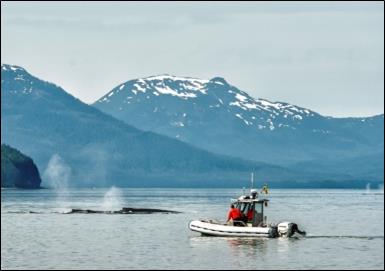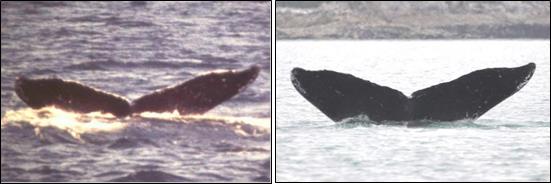Media Included
- For the Protection of Humpbacks - Take a look at the humpback whale monitoring program in Glacier Bay.
How many humpback whales are there in the Glacier Bay area?
Project Dates
Ongoing since 1985
Did You Know?
Since 1973, 740 individual humpback whales have been identified in Glacier Bay/Icy Strait. One of these whales, a male known as #441, has the longest documented humpback whale sighting history in the world: 43 years. It is not known how old this whale was when he was first sighted.
Introduction

Glacier Bay National Park’s humpback whale monitoring program is probably the longest running humpback whale photo-identification study in the world. Every year since 1985, humpback whale population characteristics in Glacier Bay and adjacent waters have been monitored to document the number of individuals, their spatial and temporal distribution, calf production, genetics, feeding behavior, and human/whale interactions including strandings, entanglements in fishing gear, and behavioral disturbance.
The primary objective of this research is to detect changes in whale abundance, distribution, and population parameters. The information obtained through the program is used to determine where and when vessel operating restrictions are needed to protect humpback whales, an endangered species. To mitigate whale disturbance by vessels, the NPS limits the number of vessels in Glacier Bay, prohibits vessels from approaching whales, and applies vessel course and speed restrictions in areas where whales congregate to feed.
The authority of the National Park Service to implement these restrictions is unquestioned today, and the professionalism of the whale management program is widely respected. It was not always so! A heated controversy swirled around management of Glacier Bay’s marine waters and specifically endangered humpback whales in the 1970s and 80s with tourism interests, cruise ship companies, and the Alaska congressional delegation pitted against environmentalists. Park management struggled, with little scientific information on which to base decisions, to broker a compromise. The history of this tumultuous period is well documented in Theodore Catton’s Land Reborn. It is a classic story of the conflict between preservation and use in national parks.
Methods
The researchers search for, observe, and photograph humpback whales in the study area from the 19’ vessel Sand Lance.
After locating whales, they take a GPS reading and record the water depth and sea surface temperature. They then photograph the dorsal fin and the underside of the flukes (tail) of each whale. They use datasheets to record information such as the start and end time of the encounter, the number of individuals, their activity, sketches of the markings on their tail flukes and dorsal fin, whale identity (if known), and feeding behavior. They sometimes record underwater sounds with a hydrophone and digital audio tape recorder.
In the off-season, the crew is involved in many projects relating to their whale research. In January 2013, Janet had the opportunity to examine humpback whale photos taken by Charles Jurasz in southeastern Alaska, dating back to 1968, which are archived at the National Marine Mammal Laboratory in Seattle, WA.
Findings

The researchers have documented an increase in the Glacier Bay/Icy Strait whale population from 41 in 1985 to 239 in 2013.
Through the use of photo-identification, whale biologists at Glacier Bay have documented the whales’ strong site fidelity to summer feeding areas. Many of the same whales return year after year to Glacier Bay and the adjacent waters of Icy Strait, including many known-aged whales that were first identified as calves.
This long-term dataset on whale biology is increasingly valuable with every additional year of data collection because it is uniquely suited for measuring population parameters, such as female age at first calving, that require continuous sighting histories of individuals.
Learn More
A wealth of information on Glacier Bay’s whales is available on the Park website at: https://www.nps.gov/glba/naturescience/humpback-whales-in-glacier-bay.htm
Also check out the Humpback Whales of Southeastern Alaska website at: http://www.alaskahumpbacks.org/
Last updated: September 28, 2016
